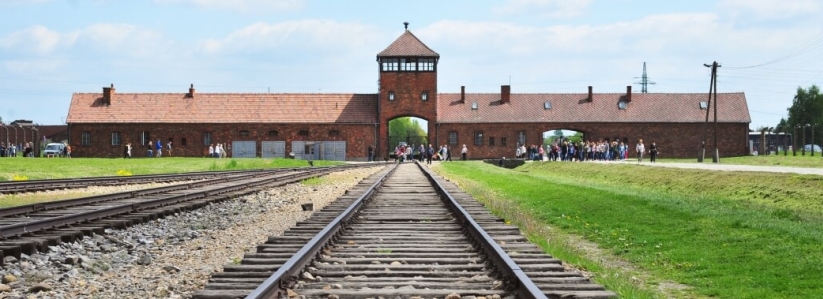By Katie Bohl and Jamie Rainton
Two sixth form students from TGS were given the opportunity to take part in the Lessons from Auschwitz programme, this involved attending seminars and visiting the concentration camp for a day. Katie and Jamie were selected after submitting applications explaining why they wanted to take part in such a worthwhile programme. They were accompanied by Miss Hodgson who took part in the seminars and the visit to support the students.
Below is a brief account of the students reflecting on the LFA programme they were lucky enough to be part of.
The first seminar by the project was in Leeds City centre. We were all privileged and honoured to bear witness, which ultimately is what this project has all been about, to the brave testimony of Eva Clarke who was born in a concentration camp. Her mother weighed 5 stone when she gave birth to Eva and remarkably they both survived. Her mother was treated despicably and risked her own life in concealing her pregnancy. It was likely her lack of nutrition allowed the pregnancy to be concealed.
Listening to Eva’s story was such a privilege but also really emotional as Eva herself got upset as she remembered her mother and what they had suffered. However, we were equally shocked when Eva said she would not blame the German people for the Holocaust which is testimony to her kind nature and the idea that people need to ensure this NEVER HAPPENS AGAIN. Eva has made it her lifelong mission, as did her mother, to assist in ensuring such a tragedy will never happen again.
We then had a week to reflect on the seminar before setting out on our journey to Auschwitz.
Upon approach to Auschwitz I we were horrifically shocked at how discreet the evil appeared to be. In the hot sunshine the blocks appeared pretty with large healthy plants outside. However nothing could prepare us for the heart breaking things we were about to see.
The striking sign which translates to “work makes free” eerily and uncomfortably invited us into the camp. Our guide told us that many feel “the sun is never truly shining in Auschwitz” this is something we all now understand. When the Jews entered this camp they will have been filled with fear from head to toe. Each block is almost identical and each one has now been transformed into an exhibition.
As we entered the blocks our hearts dropped at once and sickened feeling arose. The prisoners, clothes, spectacle and many other belongings were all in front of us. This was intensely tragic as the prisoners could never have dreamed of the cruelty they would be subjected to. However, the most sickening and upsetting part was undoubtedly the amount of prisoner’s hair that was still there. It was further disturbing and inexplicably disgusting to see that Rudolf Hess lived so close to the camp. It was extremely upsetting to see such brutality and be in knowledge that it was not a typical monster that did this, it was the human race!
At this point it was hard to imagine how the day could become more upsetting. However, our final destination in this camp was the evil and destructive part of the entire operation – the gas chambers. There is no way to explain how upsetting and truly heart breaking this room is. It makes you feel ashamed to be human.
As we approached the iconic entrance to Auschwitz Birkenau we were not prepared for what we saw. The scale of the camp was unbelievable, everything was identical and uniform. It has a cold and eerie feeling you could sense that it was a place of death.
One of the most shocking things was seeing the purpose built train tracks built to transport the victims in to the camp. As well as this an original section of one of the cattle wagons is still there. This wagon would have had over 100 people crammed inside on journeys that would last days if not weeks. There was no sanitation, hardly any food, if you survived the journey you were lucky but then obviously upon arrival things got unimaginably worse.
To stand in a place where life and death was decided was extremely upsetting and stomach churning. This was the place where Dr Mengele would choose which line would be sent to the work camp and which line would be sent straight to the gas chambers. The experience of people’s journey to Auschwitz was traumatic enough however, upon the platform this would often be the first time families were separated, often mostly with women and children being sent straight to their deaths.
We visited on a very hot day and struggled with the amount of walking in the heat- but we stopped and reflected on how this would have been for the malnourished people who were basically worked to death no matter the weather; often without shoes in the freezing winters.
The huts were almost identical, fitting thousands of people in the same room. People would share beds with strangers and often wake up to find dead bodies next to them. There was no way of keeping clean, the victims would have been woken around 5am and given a few minutes to visit the “wash room’ and toilet. This was the only place safe from the Nazis. Therefore this place was somewhere the victims wanted to work. Often in the wash room fellow inmates would show defiance to the Nazis through practising their religion or choosing not to follow the rules given.
The camp huts and buildings were almost identical in every way until we reached the bottom most secluded part of the camp surrounded by trees where the gas chambers were. Now they are just ruins, as when the Russians approached to liberate Auschwitz the Nazis tried to burn the evidence of their horrific crimes.
We were also taken to the building where camp mates would have ultimately been dehumanised, they would arrive and have to take off all their clothes and belongings, they were shaved of all their bodily hair and disinfectant was used on them, if this wasn’t humiliating and demoralising enough they were then tattooed with their identification number which was specific to Auschwitz. As we went through each room/ station we came to the end where we saw items belonging to the victims such as photographs and keys. This was very upsetting as it reminded us that these victims had brought their most important possessions with them but they still hoped they would one day get to go home.
As we approached the end of our truly eye-opening experience into the suffering and hardship felt by so many, our attention was drawn to the Rabbi who had accompanied us on our journey to Auschwitz. Throughout the day he had been involved with each and every group on the trip, making sure we all heard the extra pieces of information that expanded our knowledge into the individuals who had their lives taken from them.
In his closing speech, the Rabbi spoke of the eeriness. It was a surprisingly hot day in Poland and he commented on how Auschwitz looked somewhat beautiful, whilst in fact holding so much evil. This stuck with us because it showed how easy it is for evil to hide behind a pretty setting and gave further suggestion as to why the Nazis got away with mass genocide for so long.
The Rabbi also took the time to remind us, Anti-Semitism is still very much prevalent in society today. He chose one particular incident to tell us about. Just last summer, a family in Edinburgh with two young children were simply walking down the street when another person decided to spit at them and call them names. We personally thought of how those children would have felt, not yet understanding or perhaps knowing of the unjustified hatred that is present in this world. It is a scary thought to think that 73 years on from the events of the Holocaust, society still has not learnt from its past. As Georg Hegel famously said, ‘We learn from history, what we do not learn from history’.
The words which stuck with us the most from his speech truly capture what we believe to be a physical representation of the extent of human lives lost during the Holocaust.
If we were to hold a minutes silence for every life lost in the Holocaust, we would be silent for 11 and half years.
For us, this sentence shocked us to the point our faces could not hide our shaken reactions. The sheer length of the silence that would be held symbolises for us the unimaginable number of people who walked in the very places we walked and never came out.
It is important to us to help keep the events of the Holocaust alive in society so the tremendously horrifying tragedy can never be forgotten. It is our duty as ambassadors to ensure and pass on our knowledge of what happened all across Europe to you so you too can be part of guaranteeing that this generation, and ones to come, will never fall into such evil ever again.

